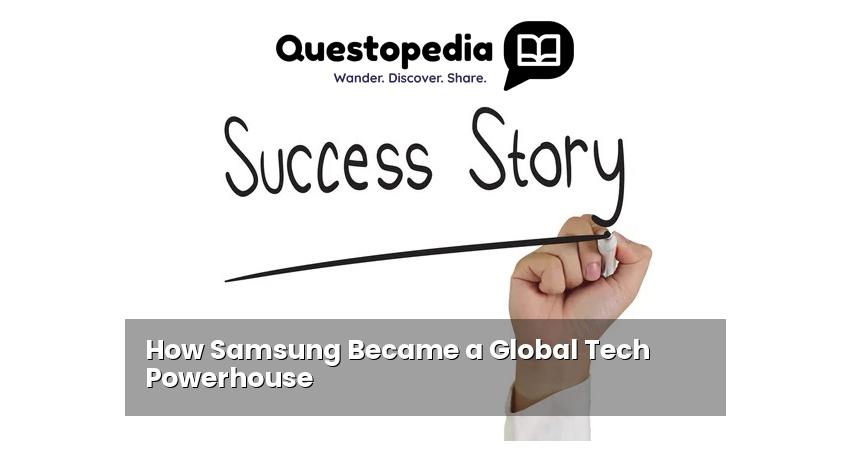How Samsung Became a Global Tech Powerhouse
Samsung. The name conjures images of sleek smartphones, vibrant TVs, and cutting-edge appliances. But the story of Samsung’s rise to global tech dominance is far more compelling than just product advertisements. From its humble beginnings as a trading company to its current status as a technological titan, Samsung’s journey is a testament to strategic vision, unwavering innovation, and a relentless pursuit of excellence.
From Trading Company to Electronics Pioneer
Founded in 1938 by Lee Byung-chul, Samsung initially focused on trading noodles and other goods. It wasn’t until the late 1960s that Samsung ventured into the electronics industry, a pivotal moment that would define its future. This early diversification was crucial. While other Korean companies concentrated on cheaper labor-intensive industries, Samsung saw the potential in technology. This strategic shift allowed them to prepare for the opportunities in a rapidly globalizing world. Learn more about the early history of Korean conglomerates on sites like Britannica.
Early Challenges and Learning from the Best
Early forays into electronics weren’t without challenges. Samsung faced stiff competition from established Japanese companies like Sony and Panasonic. However, rather than being discouraged, Samsung adopted a strategy of reverse engineering, carefully analyzing and learning from the technologies of its competitors. This involved dismantling products, studying their components, and gradually developing in-house expertise. This strategy, while controversial at the time, proved essential for Samsung’s future competitiveness.
The Semiconductor Revolution: A Turning Point
In the 1970s, Samsung made a bold decision to invest heavily in the semiconductor industry. This proved to be a game-changer. While the memory chip market was dominated by US and Japanese companies, Samsung saw an opportunity to become a key player. The company poured resources into research and development, focusing on mass production and cost-effectiveness. This investment paid off handsomely as the demand for memory chips surged in the 1980s and 1990s. This early success in the memory chip market enabled the company to reinvest more heavily in other technology sectors.
Exploiting Market Opportunities and Building Brand Recognition
Samsung’s success in semiconductors allowed it to fund further innovation and expansion. The company began to diversify its product portfolio, entering markets for televisions, mobile phones, and other consumer electronics. It strategically targeted mass markets with competitive pricing, gradually improving product quality and features. Over time, Samsung transformed its brand image from a value-oriented option to a premium brand associated with innovation and quality. You can read more about the global semiconductor industry on sites such as Statista.
The Smartphone Era: Dominating the Mobile Market
The advent of the smartphone revolution was another pivotal moment for Samsung. While Apple initially set the standard with the iPhone, Samsung quickly emerged as a formidable competitor. By embracing the Android operating system and focusing on large, vibrant displays, powerful processors, and innovative features, Samsung captured a significant share of the global smartphone market. The Galaxy series of smartphones became synonymous with Android, rivaling the iPhone in popularity and prestige.
Innovation and Ecosystem Building
Samsung’s continued success in the smartphone market is driven by its commitment to innovation. The company constantly pushes the boundaries of technology, introducing features such as foldable displays, advanced camera systems, and enhanced security measures. Furthermore, Samsung has invested heavily in building an ecosystem of connected devices, seamlessly integrating its smartphones with its smart TVs, smart appliances, and other products. This ecosystem approach helps to create a loyal customer base and strengthens its competitive advantage.
Beyond Consumer Electronics: Expanding into New Frontiers
Samsung’s ambitions extend far beyond consumer electronics. The company is actively investing in emerging technologies such as artificial intelligence (AI), 5G, and biotechnology. It is also expanding its presence in areas such as automotive technology, developing advanced driver-assistance systems (ADAS) and infotainment systems. This diversification allows Samsung to remain at the forefront of technological innovation and adapt to the evolving needs of the market.
Strategic Partnerships and Acquisitions
To accelerate its growth and expand its capabilities, Samsung has forged strategic partnerships and made key acquisitions. These collaborations allow Samsung to tap into new technologies, access new markets, and strengthen its overall competitive position. By partnering with other leading companies, Samsung can leverage its strengths and complement its weaknesses, further solidifying its position as a global tech powerhouse. More information on Samsung’s business strategies can be found at Samsung Newsroom.
Conclusion: A Legacy of Innovation and Ambition
From its humble beginnings as a trading company to its current status as a global tech powerhouse, Samsung’s journey has been nothing short of remarkable. Samsung’s success is a testament to its strategic vision, unwavering innovation, and relentless pursuit of excellence. The company’s ability to adapt to changing market conditions, invest in emerging technologies, and build a strong brand image has allowed it to become a dominant force in the global technology landscape. As Samsung continues to explore new frontiers and push the boundaries of innovation, it is poised to remain a global tech powerhouse for years to come. Visit Questopedia for more informative articles.






